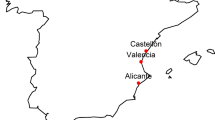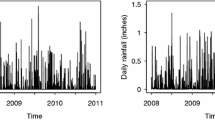Abstract
Weather derivatives represent a new and particular kind of contingent claim which shares a specific underlying weather index. These derivatives are written for different temperature indices, hurricanes, frost, snowfall and rainfall, and they are available for several cities. Our paper focuses on rainfall derivatives. In order to price this kind of derivatives, we have to model daily rainfall sequences at a specific location. For this purpose, we adopt a non-homogeneous parametric semi-Markov model to describe the rainfall occurrences, and a mixture of exponential distributions for rainfall amounts. The underlying Markov process has the obvious two states: dry and wet. In addition, dry and wet sequences are estimated by using best-fitting techniques. The model parameters are determined thanks to classical log-likelihood maximization. We finally price some rainfall contracts issued by the Chicago Mercantile Exchange through Monte Carlo simulation. The numerical applications and the parameter estimations are carried out using real data.




Similar content being viewed by others
References
Alaton P, Djehiche B, Stillberger D (2002) On modelling and pricing weather derivatives. Appl Math Finance 9(1):1–20
Barbu VS, Limnios N (2008) Semi-Markov chains and hidden semi-Markov models toward applications: their use in reliability and DNA analysis. Lecture Notes in Statistics No. 191. Springer, Berlin. doi:10.1007/978-0-387-73173-5
Barkotulla MAB (2010) Stochastic generation of the occurrence and amount of daily rainfall. Pak J Stat Oper Res VI 1:61–73
Cao M, Li A, Wei J (2004) Precipitation modeling and contract valuation: a frontier in weather derivatives. J Altern Invest 7(2):93–99
Castellvi F, Mormeneo I, Perez PJ (2004) Generation of daily amounts of precipitation from standard climatic data: a case study for Argentina. J Hydrol 289:286–302
Davidov O (1999) The steady state probabilities for a regenerative semi-Markov process with application to prevention and screening. Appl Stoch Models Data Anal 15:55–63
Detzel DHM, Mine MRM (2011) Generation of daily synthetic precipitation series: analyses and application in La Plata river Basin. Open Hydrol J 5:69–77
Di Biase G, D’Amico G, Di Girolamo A, Janssen J, Iacobelli S, Tinari N, Manca R (2007) A stochastic model for the HIV/AIDS dynamic evolution. Math Probl Eng 2007:14. doi:10.1155/2007/65636
Foucher Y, Mathieu E, Saint-Pierre P, Durand JF, Daurès JP (2005) A semi-Markov model based on generalized Weibull distribution with an illustration for HIV disease. Biometrical J 47:825–833
Garavaglia E, Pavani R (2009) About earthquake forecasting by Markov renewal processes. Methodol Comput Appl Probab. doi:10.1007/s11009-009-9137-3
Goncü A (2011) Modeling and pricing precipitation-based weather derivatives. Financial Math Appl 1(1):9–18
Haddad K, Rahman A, Green J (2011) Design rainfall estimation in Australia: a case study using L moments and generalized least squares regression. Stoch Environ Res Risk Assess 25:815–825
Hanson LS, Vogel R (2008) The probability distribution of daily rainfall in the United States. Conference proceeding paper, World Environmental and Water Resources Congress
Hardle W, Osipenko M (2011) Pricing Chinese rain: a multisite multi-period equilibrium pricing model for rainfall derivatives. SFB 649 Discussion Paper 055. Humboldt-Universität zu, Berlin
Howard RA (1971a) Dynamic probabilistic systems, vol I: Markov Models. Wiley, New York
Howard RA (1971b) Dynamic probabilistic systems, vol II: semi-Markov and decision processes. Wiley, New York
Iosifescu Manu A (1972) non-homogeneous semi-Markov processes. Stud Lere Mat 24:529–533
Jamaludin S, Jemain AA (2007) Fitting the statistical distributions to the daily rainfall amount in peninsular Malaysia. J Teknologi 46:33–48
Janssen J, Manca R (2006) Applied semi-Markov processes. Springer, New York
Leobacher G, Ngare P (2011) On modeling and pricing rainfall derivatives with seasonality. Appl Math Finance 18(1):71–91
Levy P (1954) Processus semi-markoviens. In: Erven P, Noordhoff NV. Proceedings of the International Congress of Mathematicians 3, Groningen, pp 416–426
Liu Y, Zhang W, Shao Y, Zhang K (2011) Comparison of stochastic precipitation models based on four distributions. Adv Atmos Sci 28(4):809–820
Masala G (2012) Earthquakes occurrences estimation through a parametric semi-Markov approach. J Appl Stat 39(1):81–96
Mhanna M, Bauwens W (2011) Stochastic single-site generation of daily and monthly rainfall in the Middle East. Meteorol Appl. doi:10.1002/met.256 Wiley OnlineLibrary
Musshoff O, Odening M, Xu W (2006) Modeling and hedging rain risk. American Agricultural Economics Association Annual Meeting, Long Beach
Niu J (2013) Precipitation in the Pearl River basin, South China: scaling, regional patterns, and influence of large-scale climate anomalies. Stoch Environ Res Risk Assess 27:1253–1268
Perera HKWI, Sonnadara DUJ, Jayewardene DR (2002) Forecasting the occurrence of rainfall in selected weather stations in the wet and dry zones of Sri Lanka. Sri Lankan J Phys 3:39–52
Rajagopalan B, Lall U, Tarboton DG (1996) Nonhomogeneous Markov model for daily precipitation. J Hydrol Eng 1(1):33–40
Roldan J, Woolhiser DA (1982) Stochastic daily precipitation models, a comparison of occurrence processes. Water Resour Res 18(5):1451–1459
Satten GA, Sternberg MR (1999) Fitting semi-Markov models to interval-censored data with unknown initiation times. Biometrics 55:507–513
Shi P, Qiao X, Chen X, Zhou M, Qu S, Ma X, Zhang Z (2013) Spatial distribution and temporal trends in daily and monthly precipitation concentration indices in the upper reaches of the Huai River, China. Stoch Environ Res Risk Assess. doi:10.1007/s00477-013-0740-z
Smith WL (1955) Regenerative stochastic processes. Proc R Soc Lond A 232:6–31
Sternberg MR, Satten SA (1999) Discrete-time nonparametric estimation for semi-Markov models of chain-of-events data subject to interval-censoring and truncation. Biometrics 55:514–522
Wilks DS (1999) Multisite downscaling of daily precipitation with a stochastic weather generator. Clim Res 11:125–136
Author information
Authors and Affiliations
Corresponding author
Rights and permissions
About this article
Cite this article
Masala, G. Rainfall derivatives pricing with an underlying semi-Markov model for precipitation occurrences. Stoch Environ Res Risk Assess 28, 717–727 (2014). https://doi.org/10.1007/s00477-013-0784-0
Published:
Issue Date:
DOI: https://doi.org/10.1007/s00477-013-0784-0




